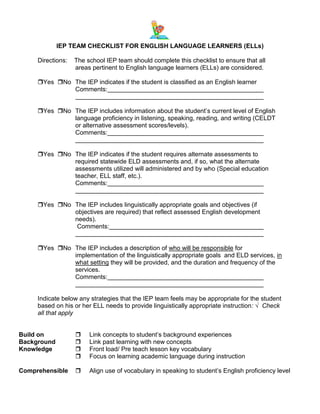Denunciar
Compartilhar
Baixar para ler offline

Recomendados
Testing Language Skills from Theory to Practice part one (Hossein Farhady)
l
این کتاب برای دانشجویان رشته مترجمی و دبیری زبان انگلیسی در مقطع کارشناسی به عنوان منبع اصلی درس آزمون سازی زبان به ارزش 2 واحد تدوین شده است.Summary of testing language skills from theory to practice part one (hossein ...

Summary of testing language skills from theory to practice part one (hossein ...Sedigh (Sid) Mohammadi
Presentation from the 2011 National Resource Center for Paraprofessionals Conference by Claudia Reinfelds.Early Reading Intervention: Increasing Personnel Involvement with Paraeducators

Early Reading Intervention: Increasing Personnel Involvement with ParaeducatorsNational Resource Center for Paraprofessionals
Mais conteúdo relacionado
Mais procurados
Testing Language Skills from Theory to Practice part one (Hossein Farhady)
l
این کتاب برای دانشجویان رشته مترجمی و دبیری زبان انگلیسی در مقطع کارشناسی به عنوان منبع اصلی درس آزمون سازی زبان به ارزش 2 واحد تدوین شده است.Summary of testing language skills from theory to practice part one (hossein ...

Summary of testing language skills from theory to practice part one (hossein ...Sedigh (Sid) Mohammadi
Presentation from the 2011 National Resource Center for Paraprofessionals Conference by Claudia Reinfelds.Early Reading Intervention: Increasing Personnel Involvement with Paraeducators

Early Reading Intervention: Increasing Personnel Involvement with ParaeducatorsNational Resource Center for Paraprofessionals
Mais procurados (19)
Vocabulary learning strategies by Wissam Ali Askar

Vocabulary learning strategies by Wissam Ali Askar
Summary of testing language skills from theory to practice part one (hossein ...

Summary of testing language skills from theory to practice part one (hossein ...
Early Reading Intervention: Increasing Personnel Involvement with Paraeducators

Early Reading Intervention: Increasing Personnel Involvement with Paraeducators
Semelhante a Jarice butterfield 3
Estimados usuarios. Bienvenidos a nuestro sitio virtual de la UNIVERSIDAD MAGISTER en Slide Share donde podrá encontrar los resultados de importantes trabajos de investigación prácticos producidos por nuestros profesionales. Esperamos que estos Mares Azules que les ponemos a su disposición sirvan de base para otras investigaciones y juntos cooperemos en el Desarrollo Económico y Social de Costa Rica y otras latitudes. Queremos ser enfáticos en que estos trabajos tienen Propiedad Intelectual por lo que queda totalmente prohibida su reproducción parcial o total, así como ser utilizados por otro autor, a excepción de que los compartan como citas de autor o referencias bibliográficas. Toda esta información también quedará a su disposición desde nuestro sitio web www.umagister.com, Disfruten con nosotros de este magno contenido bibliográfico Magister esperando sus amables comentarios, no sin antes agradecer a nuestro Ing. Jerry González quien está administrando este sitio. Rectoría, Universidad Magister. – 2016.A descriptive study of language learning strategies taught to 11th graders at...

A descriptive study of language learning strategies taught to 11th graders at...UNIVERSIDAD MAGISTER (Sitio Oficial)
Creating effective-language-lessons-combined

Creating effective-language-lessons-combinedCordova Public College and University of Cebu-LapuLapu-Mandaue
Semelhante a Jarice butterfield 3 (20)
DetailsTeachers consider many factors when developing unit 

DetailsTeachers consider many factors when developing unit
Running head TITLE IN ALL CAPS1TITLE IN ALL CAPS3.docx

Running head TITLE IN ALL CAPS1TITLE IN ALL CAPS3.docx
Challenges and Truimphs of Nonnative English Speakers in IEPs - Part 2

Challenges and Truimphs of Nonnative English Speakers in IEPs - Part 2
A descriptive study of language learning strategies taught to 11th graders at...

A descriptive study of language learning strategies taught to 11th graders at...
Clinical field experience Education homework help.docx

Clinical field experience Education homework help.docx
Clinical Field Experience C Integrating Instruction, K-3All.docx

Clinical Field Experience C Integrating Instruction, K-3All.docx
Clinical Field Experience C Integrating Instruction, K-3All.docx

Clinical Field Experience C Integrating Instruction, K-3All.docx
Mais de ECCSymposium
Mais de ECCSymposium (20)
Jarice butterfield 3
- 1. IEP TEAM CHECKLIST FOR ENGLISH LANGUAGE LEARNERS (ELLs) Directions: The school IEP team should complete this checklist to ensure that all areas pertinent to English language learners (ELLs) are considered. Yes No The IEP indicates if the student is classified as an English learner Comments: Yes No The IEP includes information about the student’s current level of English language proficiency in listening, speaking, reading, and writing (CELDT or alternative assessment scores/levels). Comments: Yes No The IEP indicates if the student requires alternate assessments to required statewide ELD assessments and, if so, what the alternate assessments utilized will administered and by who (Special education teacher, ELL staff, etc.). Comments: Yes No The IEP includes linguistically appropriate goals and objectives (if objectives are required) that reflect assessed English development needs). Comments: Yes No The IEP includes a description of who will be responsible for implementation of the linguistically appropriate goals and ELD services, in what setting they will be provided, and the duration and frequency of the services. Comments: Indicate below any strategies that the IEP team feels may be appropriate for the student based on his or her ELL needs to provide linguistically appropriate instruction: √ Check all that apply Build on Background Knowledge Link concepts to student’s background experiences Link past learning with new concepts Front load/ Pre teach lesson key vocabulary Focus on learning academic language during instruction Comprehensible Align use of vocabulary in speaking to student’s English proficiency level
- 2. Input ELD Strategies: Use of modeling, visuals, hands-on activities, demonstrations, gestures, body Use advanced organizers Provide hands-on materials learning opportunities / manipulatives Use scaffolding techniques Use linguistic frames for oral responses or cloze fill in the blank structures Use questioning strategies that promote higher order thinking skills Provide activities involving all four language domains (listening, speaking, reading, and writing) Provide opportunities for repeated practice Interaction: Provide frequent opportunities for student interaction Allow appropriate wait time for responses Group student with like peers to support language/content objectives Provide opportunities for student to clarify key concepts in L1 (preview/review, L1 instructional support, etc.) Lesson Delivery: Engage student through use of multi-modalities – especially visuals and gestures Adjust pacing of lesson to student’s needs Review key vocabulary/linguistic structures Check frequently for understanding Provide student honest, consistent feedback Review/ Assessment: Adapted from Jarice Butterfield’s ELLs With Disabilities Training Materials
